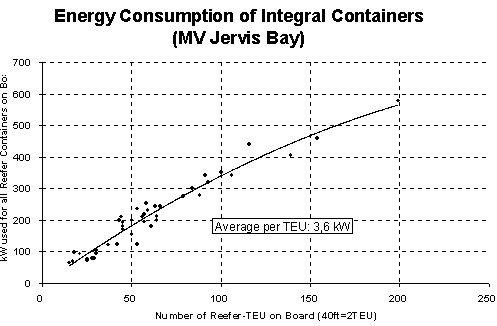The Smart Reefer from ThermoKing (the manufacturer specifications can be seen in table 11) has a maximum heat dissipation of between 24.5 and 25.5 kW at 21°C (cooling bananas), 20.5 through 22.0 kW at 2°C, 11.6 through 12.0 kW at -18°C and 7.5 through 9.1 kW at -29°C.
 |
| To enlarge the table click Table 11: Manufacturer specifications regarding the refrigeration capacity and the power consumption of a Thermo King Smart Reefer with different compressor types and refrigerants. |
These specifications by and large match those of Carrier Transicold. Here the author measured heat dissipation of 26 kW during the cooling of bananas.
Since refrigerated containers usually arrive on board in a pre-cooled state, this maximum heat dissipation is not the average heat dissipation. In low-temperature operation, the containers reduce the refrigeration capacity by switching the refrigeration unit on and off, whereas when running in chilled mode above approximately -10°C the refrigeration capacity is reduced by throttling the suction line. In reality, the heat dissipation of a cooled banana container at an ambient temperature of +45°C is approximately
12 - 13 kW, or for low-temperature operation approximately 124 - 5 kW.
The actual average heat dissipation depends very much on the type of cargo, and hence on the route and the season. In order to obtain a rough estimation of the average energy consumption and thus the average heat dissipation, the consumption figures for approximately 2,600 TEUs were recorded on a P&O vessel traveling the route from Europe to East Asia. The results are shown in Fig. 32.
 |
| Figure 32: Average electrical power consumption of refrigerated containers on the Europe-East Asia route on a P&O vessel |
The average value per TEU is approximately 3.6 kW, although the average for 20' containers is closer to 4 kW per container and 7 kW per 40' container because of the better surface/volume ratio.